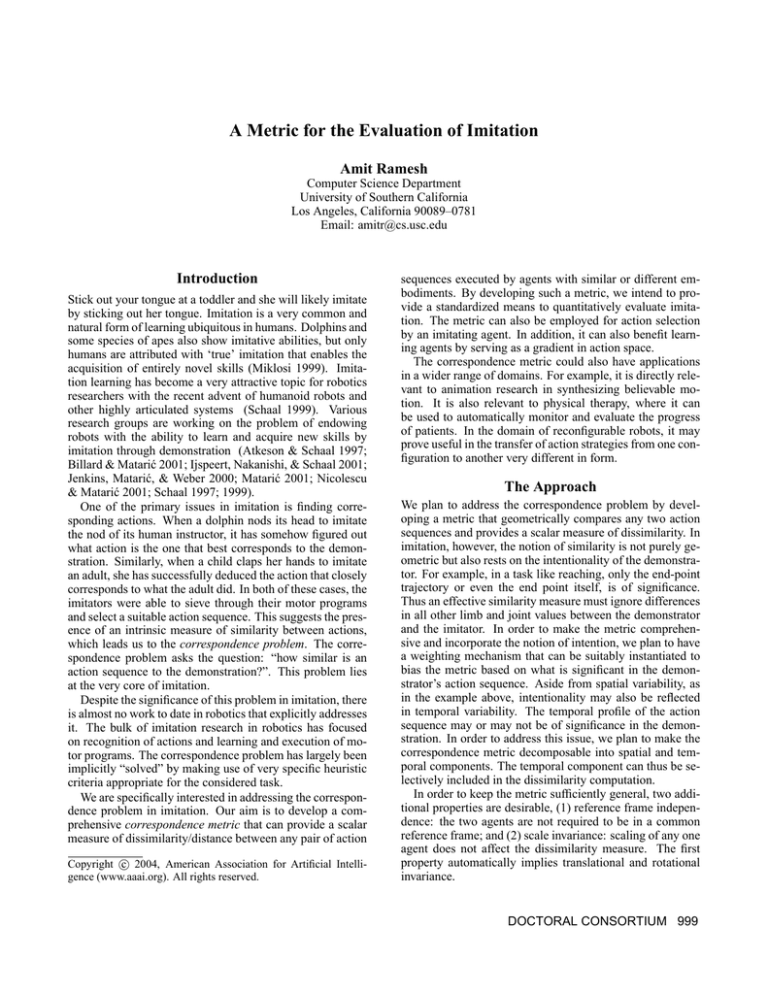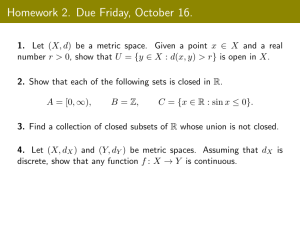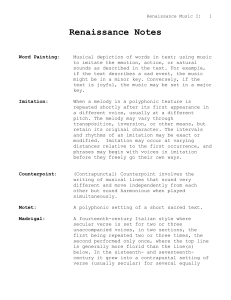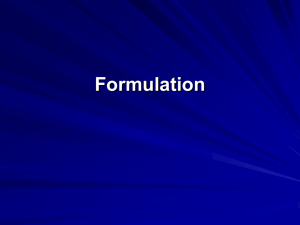
A Metric for the Evaluation of Imitation
Amit Ramesh
Computer Science Department
University of Southern California
Los Angeles, California 90089–0781
Email: amitr@cs.usc.edu
Introduction
Stick out your tongue at a toddler and she will likely imitate
by sticking out her tongue. Imitation is a very common and
natural form of learning ubiquitous in humans. Dolphins and
some species of apes also show imitative abilities, but only
humans are attributed with ‘true’ imitation that enables the
acquisition of entirely novel skills (Miklosi 1999). Imitation learning has become a very attractive topic for robotics
researchers with the recent advent of humanoid robots and
other highly articulated systems (Schaal 1999). Various
research groups are working on the problem of endowing
robots with the ability to learn and acquire new skills by
imitation through demonstration (Atkeson & Schaal 1997;
Billard & Matarić 2001; Ijspeert, Nakanishi, & Schaal 2001;
Jenkins, Matarić, & Weber 2000; Matarić 2001; Nicolescu
& Matarić 2001; Schaal 1997; 1999).
One of the primary issues in imitation is finding corresponding actions. When a dolphin nods its head to imitate
the nod of its human instructor, it has somehow figured out
what action is the one that best corresponds to the demonstration. Similarly, when a child claps her hands to imitate
an adult, she has successfully deduced the action that closely
corresponds to what the adult did. In both of these cases, the
imitators were able to sieve through their motor programs
and select a suitable action sequence. This suggests the presence of an intrinsic measure of similarity between actions,
which leads us to the correspondence problem. The correspondence problem asks the question: “how similar is an
action sequence to the demonstration?”. This problem lies
at the very core of imitation.
Despite the significance of this problem in imitation, there
is almost no work to date in robotics that explicitly addresses
it. The bulk of imitation research in robotics has focused
on recognition of actions and learning and execution of motor programs. The correspondence problem has largely been
implicitly “solved” by making use of very specific heuristic
criteria appropriate for the considered task.
We are specifically interested in addressing the correspondence problem in imitation. Our aim is to develop a comprehensive correspondence metric that can provide a scalar
measure of dissimilarity/distance between any pair of action
c 2004, American Association for Artificial IntelliCopyright °
gence (www.aaai.org). All rights reserved.
sequences executed by agents with similar or different embodiments. By developing such a metric, we intend to provide a standardized means to quantitatively evaluate imitation. The metric can also be employed for action selection
by an imitating agent. In addition, it can also benefit learning agents by serving as a gradient in action space.
The correspondence metric could also have applications
in a wider range of domains. For example, it is directly relevant to animation research in synthesizing believable motion. It is also relevant to physical therapy, where it can
be used to automatically monitor and evaluate the progress
of patients. In the domain of reconfigurable robots, it may
prove useful in the transfer of action strategies from one configuration to another very different in form.
The Approach
We plan to address the correspondence problem by developing a metric that geometrically compares any two action
sequences and provides a scalar measure of dissimilarity. In
imitation, however, the notion of similarity is not purely geometric but also rests on the intentionality of the demonstrator. For example, in a task like reaching, only the end-point
trajectory or even the end point itself, is of significance.
Thus an effective similarity measure must ignore differences
in all other limb and joint values between the demonstrator
and the imitator. In order to make the metric comprehensive and incorporate the notion of intention, we plan to have
a weighting mechanism that can be suitably instantiated to
bias the metric based on what is significant in the demonstrator’s action sequence. Aside from spatial variability, as
in the example above, intentionality may also be reflected
in temporal variability. The temporal profile of the action
sequence may or may not be of significance in the demonstration. In order to address this issue, we plan to make the
correspondence metric decomposable into spatial and temporal components. The temporal component can thus be selectively included in the dissimilarity computation.
In order to keep the metric sufficiently general, two additional properties are desirable, (1) reference frame independence: the two agents are not required to be in a common
reference frame; and (2) scale invariance: scaling of any one
agent does not affect the dissimilarity measure. The first
property automatically implies translational and rotational
invariance.
DOCTORAL CONSORTIUM 999
We are approaching the problem of developing the correspondence metric by first developing a pose metric that provides dissimilarity measures between static postures/poses
of agents. We will then extend it to the comparison of action
sequences.
In order to compare poses of agents, we require a uniform representation to encode them. We have chosen to treat
agents as open kinematic chains, and therefore encode their
structure in a tree termed kinematic tree or k-tree. We have
introduced the following definitions.
Definition 1 (k-tree) A kinematic tree or k-tree is an encoding of an open kinematic chain such that every link in
the kinematic chain is represented by a unique edge in the
k-tree.
Definition 2 (Pose) A pose p of a k-tree t is an assignment
of the ordered pair hni , li i to every edge ei of t. ni is a unit
normal that is the orientation of the link, represented by ei ,
in the world coordinate frame. li is the length of the link
represented by ei .
Definition 3 (Homeomorphic pose class) A homeomorphic pose class P is a set of poses such that for any pair of
poses p, q ∈ P , if tp is the k-tree of p and tq the k-tree of q
then tp and tq are homeomorphic.
We have developed a pose distance algorithm that takes
a pair of poses from a homeomorphic pose class as input,
and computes a distance measure between the poses. The
algorithm first realigns the two poses and brings them to a
common reference frame, then partitions the edges of the
individual k-trees of the two poses, then uses the underlying homeomorphism between the k-trees of the two poses
to find matchings between the partitions of the k-trees. Dissimilarity measures are computed between every such pair
and these are summed up to obtain the dissimilarity measure
for the pair of poses. The distance measure computed by
the pose distance algorithm satisfies properties (1) and (2)
desired of the correspondence metric. We have successfully
applied the pose metric across various poses of a human, the
Sony AIBO dog, and a simulated dolphin-like skeleton.
We have recently used multi-dimensional scaling (MDS)
followed by principal component analysis (PCA) to project
poses as distributions on a common space. We are investigating the use of transportation cost functions in order to
provide measures of pose distance without the homeomorphic pose class constraint.
Related Work
Nehaniv et al. (Nehaniv & Dautenhahn 2000; 2001) have
used abstract algebra as a means to formalize the correspondence problem. Their work provides an abstraction where,
given elementary correspondences, one can employ a suitable metric and analyze more complex sequences. The metric is crucial to the process of determining correspondences,
but their work does not address the issue of determining
a metric. Alissandrakis et al. (Alissandrakis, Nehaniv, &
Dautenhahn 2002; 2003) have explored some metrics for
this formal framework and applied them to different agents.
1000
DOCTORAL CONSORTIUM
However these metrics are only suitable to the specific problem considered. We are interested in developing a generalized metric that can be applied to different domains.
References
Alissandrakis, A.; Nehaniv, C. L.; and Dautenhahn, K.
2002. Imitating with alice: Learning to imitate corresponding actions across dissimilar embodiments. IEEE Transactions on Systems, Man, and Cybernetics—Part A: Systems
and Humans 32(4):482–496.
Alissandrakis, A.; Nehaniv, C. L.; and Dautenhahn, K.
2003. Synchrony and perception in robotic imitation
across embodiments. IEEE International Symposium on
Computational Intelligence in Robotics and Automation
32(4):923–930.
Atkeson, C. G., and Schaal, S. 1997. Robot learning
from demonstration. International Conference on Machine
Learning 12–20.
Billard, A., and Matarić, M. J. 2001. Learning human
arm movements by imitation: Evaluation of biologicallyinspired connectionist architecture. In Robotics and Autonomous Systems, volume 37:2-3, 145–160.
Ijspeert, A. J.; Nakanishi, J.; and Schaal, S. 2001. Trajectory formation for imitation with nonlinear dynamical systems. In Proceedings of the IEEE/RSJ International Conference on Intelligent Robots and Systems (IROS 2001),
752–757.
Jenkins, O. C.; Matarić, M. J.; and Weber, S. 2000.
Primitive-based movement classification for humanoid imitation. In First IEEE-RAS International Conference on
Humanoid Robotics (Humanoids-2000).
Matarić, M. J. 2001. Visuo-motor primitives as a basis
for learning by imitation: Linking perception to action and
biology to robotics. In Dautenhahn, K., and Nehaniv, C.,
eds., Imitation in Animals and Artifacts, 392–422. MIT
Press.
Miklosi, A. 1999. The ethological analysis of imitation.
Biological Review 74:347–374.
Nehaniv, C. L., and Dautenhahn, K. 2000. Of hummingbirds and helicopters: An algebraic framework for interdisciplinary studies of imitation and its applications. Interdisciplinary Approaches to Robot Learning, World Scientific
Series in Robotics and Intelligent Systems 24, World Scientific Press:136–161.
Nehaniv, C. L., and Dautenhahn, K. 2001. Like me? – measures of correspondence and imitation. Cybernetics and
Systems: An International Journal 32(1-2):11–51.
Nicolescu, M., and Matarić, M. J. 2001. Learning and
interacting in human-robot domains. Special Issue of IEEE
Transactions on Systems, Man, and Cybernetics, Part A:
Systems and Humans 31(5):419–430.
Schaal, S. 1997. Learning from demonstration. Advances
in Neural Information Processing Systems 9:1040–1046.
Schaal, S. 1999. Is imitation learning the route to humanoid robots? Trends in Cognitive Sciences 3(6):233–
242.



